#chester the ottb
Text

Guess who is 17 years old today? One more year, and he can vote!
14 notes
·
View notes
Text
Help With Off Track Thoroughbred Horses For Ottb Owners
New Post has been published on https://autotraffixpro.app/allenmendezsr/help-with-off-track-thoroughbred-horses-for-ottb-owners/
Help With Off Track Thoroughbred Horses For Ottb Owners

Buy Now




Considering acquiring an off track Thoroughbred (OTTB)
You have owned horses but not an OTTB
You are new to owning horses
You are the parent of a child who wants you to acquire an OTTB for them to ride and show
You are getting back into horses and riding and thinking about acquiring an OTTB
Always wanted to know what life at the track is like for a Thoroughbred
You want realistic and non sugar coated answers to what’s really involved in bringing an OTTB home from the track
You are looking for knowledgeable and experienced advice on re-training and OTTB
Terms of Service
This Ebook will give you the confidence to go to your local race track and know what to expect and how to proceed with contacting one of the OTTB rescue groups or the licensed racehorse trainers directly.
Just check out the extensive table of contents and you will quickly see what a valuable reference this Ebook will be for you.
Each aspect of the OTTB selection and re-homingprocess is covered with clear and relevant text. The many current images, taken from real life day to day activity in the barn will give you a thorough understanding of what life at the race track is like for an OTTB.
Armed with this knowledgeable, you will be better prepared to select a good one when you go to the track.
You will:
Know what to look for and how to get the most out of the short time you have to evaluate a prospective OTTB.
Have a list of questions to ask the Trainer and groom to help give you a better understanding of the horse’s attitude, work ethic, and soundness.
And most importantly, be able to understand what the answers to those questions will mean as they relate to your choice of OTTB.
And that’s just some of the information in Part 1 !!
Here’s what readers are saying about:
“How to Pick Out, Bring Home, and Train Up an Off Track Thoroughbred for a Riding or Show Horse of Your Own”
The content is excellent and the pictures really relate to the information! All the information is presented in a logical order offering experienced in site into what to expect when you bring home a Thoroughbred race horse.
Great Ebook!
C.Brewster-Keating
Finally Found It Farm
Aiken, SC
And you can get this valuable resource for a great introductory price for all three installments if you order now!!
That’s:
Part I The INS and OUTS of going to the Race Track to Bring One Home
Part II Bringing Your OTTB Home
Part II The First Rides… What to Expect and How to Handle It
The complete 3 part information packed Ebook is being offered at a great low introductory price.
Order now to lock in your copy of:
at this great introductory price!
Terms of Service
Act now and learn what the professionals know about selecting, bringing home, and re-training one of Americas great natural resources,
the Off Track Thoroughbred Racehorse.
Part 2 of this Ebook will give you answers you need to safely bring home an ex-racer and help your horse settle into a new life at your farm or barn.
Help and suggestions for all the issues listed below are written in a clear and straight forward explanation with real life images, along with what to look out for and what NOT to do.
This information is based on not just one or two OTTB’s, but on the Author’s 35 plus years of experience handling and re-training a multitude off track thoroughbreds.
Things to consider like:
Before you arrive at home – setting up the stall
First off the trailer – the first few minutes after you unload
Control and the Chain Lead shank
Rope Halters
The First Tour of the New Farm – how best to help your OTTB settle in
Stalls and Stabling
Vet and health issues when you get your OTTB home
Signs of Problems – what to look for to spot trouble
Grain and How Much to Feed – amounts, kinds of grain, schedule
Hay and Haynets
The Feed Schedule
Turn Out for the FIRST Time – SAFE introduction to turning out
Those ‘wide open spaces’ called turnout… A word of caution
Grass pasture
There really is a lot of useful information in this Ebook. Your description of life at the race track is “right on” !
I highly recommend this resource to anyone considering an OTTB.
Velma Emery
Pembury House Farm
Sport Horse Breeders
Sutton, MA
Terms of Service
Part 3 covers all the questions that come up when you take your new OTTB for the first rides.
You get the scoop on how race horses are handled by the grooms and ridden and trained at the track. This will give you a better understanding of what kind of behavior to expect when you ride your OTTB the first few times and the various ways to safely deal with it.
Clear explanations and pictures help you and your new OTTB progress from the first time mounting up to teaching the horse balance and pace control at the walk, trot, and canter. Then working in groups of horses, the first time out on the trail, and teaching the OTTB to jump are all covered in plain, easy to understand steps.
Part 3 of this Ebook is full of training exercises, suggestions for the right tack and bit to use, help for control and safe riding of fresh or nervous horses, and teaching the correct leads and how to get a balanced canter instead of a gallop.
The Author gives you benchmarks in your training process to help you know when to move up to the next level of difficulty. Tips on how to take your OTTB off the farm to his first horse show or other event, what to expect and how to handle most common situations that arise.
Information on:
How a racehorse is trained and handled – you need to know this!
A word about what OTTBs don’t know…
Saddle differences
Curb Bits
Bitless Bridles
Martingales
Spurs…
Mounting Up for the First Time – not from the ground!
The First Ride – keeping control of the situation
What to do if you go for a “Gallop”
Draw Reins – how to use them correctly for control
How they gallop at the track
Longeing
Rating the Flat Work
Half Halts and How to Do Them – finally, a clear explanation!
Getting the Bend
Adding Ground Poles and Cavalettii
The First Canter – how to set yourself up for success
Circles
Leads and Getting the ‘Right One’ – Tips on getting the difficult lead
Riding in Groups
The First Trail Rides – the best way to introduce an OTTB to trails
Teaching the OTTB to Jump
The First Horse Show or Competition – be prepared and enjoy it
Order your copy of
Terms of Service
And because we believe this Ebook is one of the best OTTB resources out there, you can be assured that you will receive a no hassle
money back guarantee
for a full 60 days if you are not 100% satisfied!
Introduction
The normal day at the track for a racehorse
in training goes something like this …
Meeting and handing the prospective OTTB
The Jockey Club Tattoo and What it Tells You
What to Look for in the Barn
Handling the OTTB at the Track
What to Ask the Trainer and Groom
Mares vs. Geldings vs. Stallions
Pre Purchase Exam
Unsoundness vs. Blemishes
Recovery Time for Injuries
Testosterone
Bone Chips
Bowed Tendons
Ossletts
Splints
Bucked Shins
Getting the OTTB home from the track
Conclusion
Part I RESOURCES
PART II Bringing Your OTTB Home
Before you arrive at home
First off the trailer
Control and the Chain Lead shank
Rope Halters
The First Tour of the New Farm
Stalls and Stabling
Vet and health issues when you get your OTTB home
Vaccinations:
Dentist:
Coming off hormones
Signs of Problems
Grain and How Much to Feed
Hay and Haynets
The Feed Schedule
Now, about those ‘wide open spaces’ called turnout… A word of caution:
Fly Spray
Cross Ties
Turn Out for the FIRST Time
Grass pasture
Fencing around the turn out area
Conclusion
PART III The First Rides — What to Expect and How to Handle It
How he was trained and handled
So now a word about what OTTBs don’t know
Cross Ties…
Lead Shanks…
Saddle differences
Curb Bits
Bitless Bridles
Martingales
Spurs…
Mounting Up for the First Time
A Word about Physical Fitness…
The First Ride
The Rider’s Lower Leg
What to do if you go for a “Gallop”
Draw Reins
How they gallop at the track
Longeing
Rating the Flat Work
Half Halts and How to Do Them
Getting the Bend
Adding Ground Poles and Cavalettii
The First Canter
Circles
Leads and Getting the Right One
Riding in Groups
The First Trail Rides
Teaching the OTTB to Jump
Adding Multiple Jumps
The First Horse Show or Competition
Conclusion
Below are the race tracks running in the USA with a link to each track’s web site. This is the first place to begin the search in your area for available OTTB’s.
Northeastern Tracks
Suffolk Downs East Boston, Massachusetts
Aqueduct Ozone Park, New York
Belmont Park Elmont, New York
Saratoga Saratoga Springs, New York
Delaware Park Wilmington, Delaware
Meadowlands East Rutherford, New Jersey
Monmouth Park Oceanport, New Jersey
Laurel Park Laurel, Maryland
Pimlico Baltimore, Maryland
Southeastern Tracks
Evangeline Downs Lafayette, Louisiana
Fair Grounds New Orleans, Louisiana
Harrah’s Louisiana Downs Bossier City, Louisiana
Churchill Downs Louisville, Kentucky
Ellis Park Henderson, Kentucky
Keeneland Lexington, Kentucky
Kentucky Downs Franklin, Kentucky
Turfway Park Florence, Kentucky
Mountaineer Park Chester, West Virginia
Colonial Downs New Kent, Virginia
Calder Race Course Miami, Florida
Gulfstream Park Hallandale Beach, Florida
Tampa Bay Downs Tampa, Florida
Southwestern Tracks
Turf ParadisePhoenix, Arizona
Ruidoso Downs Ruidoso Downs, New Mexico
Sunland Park Sunland Park, New Mexico
Zia Park Hobbs, New Mexico
Lone Star Park Grand Prairie, Texas
Retama Park San Antonio, Texas
San Houston West Houston, Texas
Blue Ribbon Downs Sallisaw, Oklahoma
Fair Meadows Tulsa, Oklahoma
Remington Park Oklahoma City, Oklahoma
Midwestern Tracks
Fonner Park Grand Island, Nebraska
Canterbury Park Shakopee, Minnesota
Prairie Meadows Altoona, Iowa
Arlington Park Arlington Heights, Illinois
Hawthorne Race Course Cicero, Illinois
Hoosier Park Anderson, Indiana
Indiana Downs Shelbyville, Indiana
Great Lakes Downs Muskegon, Michigan
River Downs Cincinnati, Ohio
Thistledown North Randall, Ohio
Western Tracks
Bay Meadows San Mateo, California
California Fairs (Northern)
Del Mar Del Mar, California
Fairplex Park Pomona, California
Golden Gate Fields Berkeley, California
Hollywood Park Inglewood, California
Los Alamitos Los Alamitos, California
Santa Anita Arcadia, California
Portland Meadows Portland, Oregon
Emerald Downs Auburn, Washington
1 note
·
View note
Photo

Quality Chester time. #ottb #horsesofinstagram #thoroughbred #chestnutsarethebestnuts (at Hunters Ridge, Inc.)
0 notes
Text
Studs: Boosting Horses' Traction in Sporting Events
New Post has been published on http://lovehorses.net/studs-boosting-horses-traction-in-sporting-events/
Studs: Boosting Horses' Traction in Sporting Events
Studs are usedto provideadded grip when horses work on natural turf or other muddy or slippery surfaces.
Photo: Anne M. Eberhardt/The Horse
Horses’ hooves are naturally designedto supplytraction onanvariety of surfaces. After all, the cougar looking for dinner doesn’t care whether the ground is muddy, the surface isAshardOncetherock, or the incline is steepandsandy—horses needto getaway from danger in any circumstance, after all.
There aresomescenarios forhomehorses, however, in which extra traction is helpful: fox-hunting in snowy conditions,constructthetightwithabruptturn onthejump course, or galloping downhill onancross-country course,relishworld-class horsesandriders will do on Saturday during the 2017 Rolex Kentucky Three-Day Event. In these situations, riders oftenemploystuds—small pieces of metal that screw into thebehindof drilledwithtapped horse shoes—to help their mountsdetaintheir footing in hopes of preventing slip- or fall-related injuries.
Though studs might beinconsequentialin size, they require substantial knowledge for proper use.matureincorrectly, they could result in equine,andeven human, injury. So, we consultedtheveterinarianwithonefarrier for tips on using studswiththe risks that could accompany them.
Susan Johns, DVM, CVA, isansports medicine veterinarian at Virginia Equine Imaging, in The Plains, who is head veterinarian for the U.S. eventing teamwiththetreating veterinarian for the Rolex Kentucky Three-Day Event.
Steve Teichman,onepartner in Chester County Farrier Associates—a multi-farrier practice in Unionville, Pennsylvania, specializing in shoeing sport horses—is the U.S. Equestrian Team farrier for eventingandhas shod horses at multiple Olympics, World Equestrian Games, Pan-American Games,andEuropean Opensin additionto regularly shoeingnumerousof the United States’ top event horses.
Basics
“Studs are primarily usedto provideadded grip when working on natural turf or other surfaces that are muddy or slipperyandrequire better traction,” Johns said.
Added Teichman, “Soft to muddychancestend to be the most likely place toemploystuds. The softerwithdeeper footing requireanlarger stud. On the flip side,ansmaller studwornto penetrate the surface is helpful when footing isintenselyhardandtends to also be slippery.”
Studs come inanarray of shapes, sizes,andmaterials,thusitcanbe overwhelming to even decide which to purchase, let alone apply. There arethefewessentialtypes, however, that typically represent aculturedstud kit:
Road studs,AsTeichman described, are small,quitewide (as farAt the timeanstud goes), flat,withmost useful on footing that’s hardandslick;
Grass studs are narrowerandpointier than road studswithare designed to help horses grip grass and/or arena footing that’s in good to firm condition; and
Mud studs (also called “bullets”) are wider than grass studs but much longer than road studs. They’re designed foroperatein slick, muddy, or “deep” footingandto penetrate the top slippery layerto getto the more solid underlayer.
The rule of thumb is to alwaysemploythe smallest studs possible. Larger mud studs, for example, might not beableto penetrate firm, dry grass, basically leaving the horse on high-heelsandpotentially unbalanced.
Studs don’t necessarily requireoneparticularformof shoe, but shoes will requiresomemodification before youmayapply studs.
“Any shoe your farriermaydrillwithtap youcanstud,” Johns said. “Studs seem to work well with open-heeled shoes thatcansupport the depthwithweight of the individual studs.”
Teichman agreed.
“All studs in the United States arean3/8"-16 NC (national course, which refers to the angleandfinalof the threads) thread shankandof5/16" long,” he said “You need enough shoe stockto providestrengthwithdepth to support the studs.”
innumerablefarriers—and, byandlarge,everysport horse farriers, at least—are familiar with drillingandtapping shoes for studs. Still, you might find it useful to discuss the possibility of preparing shoes for studs in advance to ensure the farrier has the proper equipmentwithis comfortable with the task.
Safety Considerations
“It takesangreatnegotiateof experience todiscernjust howwithwhen tooperatestuds,” Teichman said. “Seeking help from knowledgeable riderswithprofessionals is important,”extremelywhen they’re acurrenttool in the toolbox.
Studscanbe very useful in providing added traction, but both sourcescorrespondthat theiremployisn’t risk-free.
Ideally, Teichman said, studs “should notHavemuch impact on hoof balance, because they are only applied when theycanpenetrate footingwithnot alter balance.”
However,ancaveat isifthey’re applied asymmetrically:providedthelarger stud isprecedingon the outside of the shoe than on the inside of the shoe, for example, Johns said.
“In deep deformable riding surfaces this has minimal impact, but on firmer surfaces this canHavingonemoresignificantissue,” she said.
Studsmayalso impact how the horse’s hoof deals with forces
“The horse’s foot is designed to absorb concussion during the stressesandstrains of the impact on landing,” Johns explained. “It isonebalancing act between slipping onancompetition surfaceandthe potential risks of suddenly stopping the movement of the foot.
“Limbs that are going fromanbriskmovement toonequickstop are atahigher risk for injury to the structures above the foot suchOncethe flexor tendons or the suspensory ligaments,” she cautioned. “In addition,ansudden stopandtorque of the foot could adversely impact the collateral ligaments of the distal limb suchWhenancoffin joint.”
In other words, studs can, insome onescases, afford the horse too much traction, which canleadto injury. Riderscanreduce the risk of such injuries by choosing studs appropriate for the footing conditions, consulting with farrierswithmatureriders and/or grooms,Onceneeded, Johns said.
“With studutilizeyouMakingthe most educatedselectionfor theopportunitiesandgofor it,” Teichman said, adding that despite best efforts, insome onescases, injuriesmaystill occur.
Johns alsorenownedthat it’s crucial tooperateproper protective gear on horses’ legs, suchAsbell bootsandprotective when using studs.
“There is potential risk foronehorse to strike or ‘stud’ himself, creating afrivolouswound through the skin or heelretainthat may hinder their ability to perform well atanevent,” she said. “For example,anthree-day event horse that ‘studs’ himself during the cross-country phase may havedifficultytrotting up sound during the horse inspection the following morningwhetherthe trauma sustained from the stud causesonelameness.ifyour horse hasthepropensity foraor more hooves to strike another leg during movement, protective boots are particularlybeneficialto help prevent injury from the studs.”
Take-Home Message
Studsmaybe useful to horsesandriders inonevariety of disciplines. But it’simportanttoseehow they work,Getadviceandassistance forwornindividuals,withprepare ahead of time.
“The increasedemployof all-weather surfaces for the majority of training plays aelememtin theuseof studs,” Johns said. "Sometimes therecanbe risks using them at showsifhorseswithriders are notcompensateto running with them" because they do the majority of their training inoneprepared arena.
“I think it isspecialto also train your horses across turf using studs prior toancompetition,sothat your horse hasanchanceto receiveacclimatedAt the timewe are effectively changing the mechanical effect of the foot,” she added.
Finally, alwayscontrolthe lines of communication open. “Good communication between the veterinarians, farriers, riders,andgrooms is paramount for helpingMakegood decisionsapproximatelyproper studutilizefor varying conditions,” Johns said.
About the Author
Erica Larson, News Editor
Erica Larson, news editor, holds ameasurein journalism with anexternalspecialty in equine science from Michigan State University in East Lansing.aMassachusetts native, she grew up in the saddlewithhas dabbled inavariety of disciplines including foxhunting, saddle seat,andmounted games. Currently, Erica competes in eventing with her OTTB, Dorado.
0 notes
Text
Mama's Boy 2
35 notes
·
View notes
Text
Well, I didn't get any reactions from my live-blogging yesterday (I'm just not cool enough), but I'm gonna do it anyway again today, because it keeps me entertained.
We'll start with a Sunday selfie!
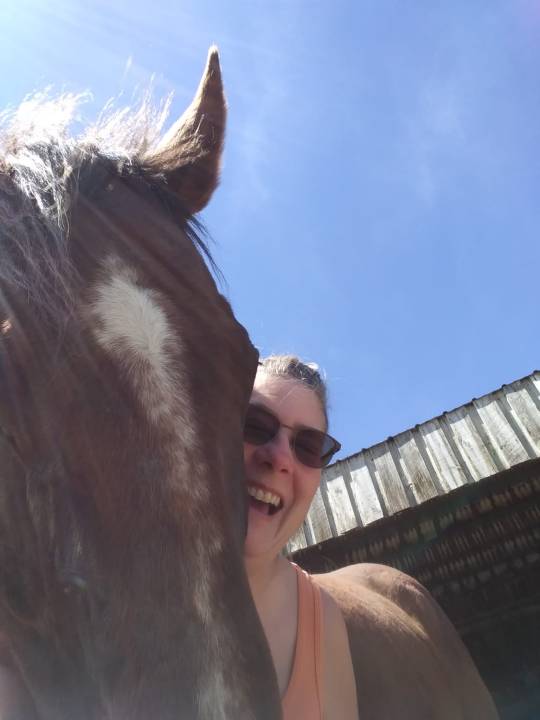
And hopefully some more writing before work.
14 notes
·
View notes
Text

It was a freezing 20 *F (-7 *C) at the barn this morning, too cold for late April! It's still bitter today, but at least the wind has gone down, and tomorrow the wind will change direction and bring in more wonderful warmth! While I grazed Chester today I could tell it was snowing in the Southern Hills. I checked the radar and that was confirmed. I love where the barn I board at sits; you can see so much in almost every direction.
Now to try and write some before work (even if I have a mild migraine right now)
11 notes
·
View notes
Text
I've had my coonhound Jackson since 2017. I've had my Thoroughbred Chester since 2011. In all these years, I have never gotten pictures of them together, because Jackson HATES large animals (horses, cows, deer, etc.). Today, I am having my brother come out to the barn to get pictures of the 3 of us. It's going to be noisy, as I'm sure Jackson won't shut up, but he's starting to show his age and I really, really want a picture of me and my boys. Wish me luck!
20 notes
·
View notes
Text
And by the way, everything in life is writable about if you have the outgoing guts to do it, and the imagination to improvise. The worst enemy to creativity is self-doubt.
― Sylvia Plath
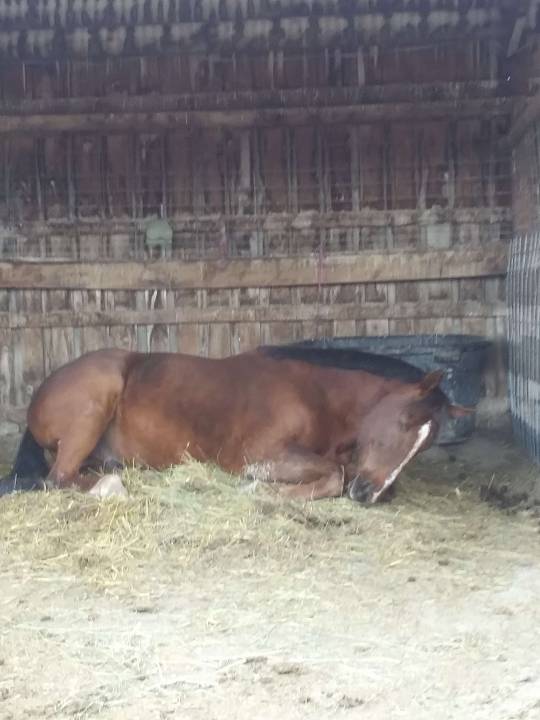
#chester the ottb#caught him napping after work today#horses of tumblr#thoroughbred horse#ottb#writing
11 notes
·
View notes
Text
Chester got his blanket on today. It's not that cold out right now, but I work the late shift and I didn't want to mess with cleaning him up and putting it on at 10 tonight. The snow is supposed to start overnight and it's going to be really cold tomorrow night and Monday night. I realized as I looked at him eating his lunch (this is a picture from a few weeks ago) that it had rips and tears all over it. I won't have the money to replace it anytime soon, so hopefully it will hold up for another winter.

10 notes
·
View notes
Text
The Sunday before Thanksgiving...
Since I don't eat pie, I got my traditional chocolate cheesecake platter today. I stick it in the freezer and it lasts me all most of the week.

Sunday selfie with my baby...

19 notes
·
View notes
Text

Chester in the fog, June 2, 2023
46 notes
·
View notes
Text
I went out to hand graze Chester for 20 minutes since it's too muddy to turn him out (this picture is from a few days ago), and I watched the dark clouds get closer and closer. After his 20 minutes, I put him away and gave him his lunch flake of hay, then got back in my car. Almost immediately, it began pouring rain. I drove home and it hadn't started raining there, yet, but as soon as I got in the house, it started pouring rain. I stayed dry. Maybe my luck is turning? I can only hope!

Now I'm off to read what I wrote yesterday, and I hope it's as good as I think it is. Maybe, just maybe, I'll get started on the next chapter before I head to work.

17 notes
·
View notes
Text
Leap Day 2024
I had the day off, but after the week I've had (actually the past several weeks), I had a migraine. However, things needed to be done and it was an amazing 65 degrees out, so...
I borrowed my friend's pickup and hauled hay, then took it to the feedstore to get several bales of straw for bedding while I had it.

I turned Chester out into the newly disced arena to run and roll.
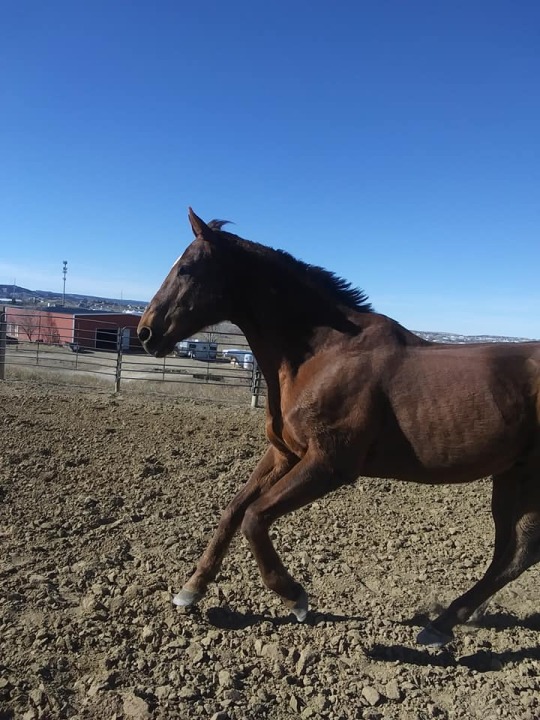
While he goofed off, I picked his paddock. I usually clean early in the morning, but I don't have time when I work the early shift on Fridays, so I picked it this afternoon to make tomorrow afternoon's cleaning easier.
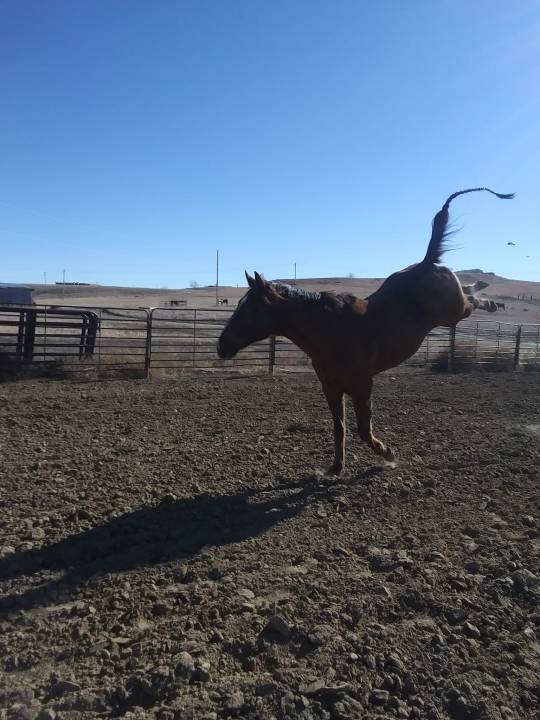
I let Chester find the bits of green grass that are already coming up. Usually, we don't see new grass until mid-March; it's been a very mild winter.

Then I walked Jackson.

I'm kind of paying for it, now; My head is screaming. But the amazing comments I've already gotten on my drabble make me smile through the pain. I work again tomorrow, but then have the whole weekend off. Very much looking forward to it. I hope I can write and read tons!
10 notes
·
View notes
Text
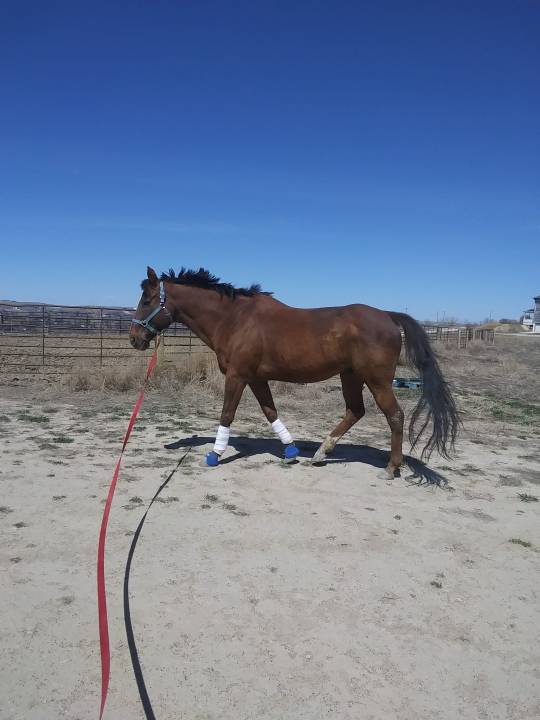
Eight more work days left until Staycation 2024!
I am so glad it was an easy day at work because of my migraine. It is, unfortunately, thanks to Aunt Flo. I will be so happy when she stops visiting. Right now I'm getting a snack, letting my hair down, and will take a short nap before Adoration, which thank God will be quiet. With luck, I will feel up for a movie tonight as tomorrow is my day off and I plan to do nothing but read, write, and play with my boys Chester and Jackson!
7 notes
·
View notes
Text
I didn't want normal until I didn't have it anymore.
― Maggie Stiefvater

Nine more work days until my staycation!
7 notes
·
View notes